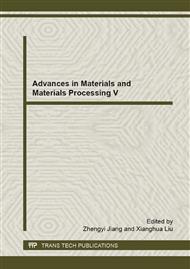[1]
F. Meng, R. Li, Q. Li, W. Lu, T. -W. Chou, Synthesis and failure behavior of super-aligned carbon nanotube film wrapped graphene fibers, Carbon, 72 (2014) 250-256.
DOI: 10.1016/j.carbon.2014.01.073
Google Scholar
[2]
A. Sakhaee-Pour, Elastic buckling of single-layered graphene sheet, Comp Mater Sci, 45 (2009) 266-270.
DOI: 10.1016/j.commatsci.2008.09.024
Google Scholar
[3]
J.C. Meyer, A.K. Geim, M. Katsnelson, K. Novoselov, T. Booth, S. Roth, The structure of suspended graphene sheets, Nature, 446 (2007) 60-63.
DOI: 10.1038/nature05545
Google Scholar
[4]
Y. Zhou, Y. Chen, B. Liu, S. Wang, Z. Yang, M. Hu, Mechanics of nanoscale wrinkling of graphene on a non-developable surface, Carbon, (2015).
DOI: 10.1016/j.carbon.2014.11.055
Google Scholar
[5]
B. Liu, Y. Huang, H. Jiang, S. Qu, K. Hwang, The atomic-scale finite element method, Comput Method Appl M, 193 (2004) 1849-1864.
DOI: 10.1016/j.cma.2003.12.037
Google Scholar
[6]
B. Liu, H. Jiang, Y. Huang, S. Qu, M. -F. Yu, K. Hwang, Atomic-scale finite element method in multiscale computation with applications to carbon nanotubes, Phys Rev B, 72 (2005) 035435.
DOI: 10.1103/physrevb.72.035435
Google Scholar
[7]
Y. Chen, B. Liu, K-C. Hwang and Y. Huang. A Theoretical Evaluation of Load Transfer in Multi-wall Carbon Nanotubes. Carbon, 2011, 49(1): 193-197.
DOI: 10.1016/j.carbon.2010.09.003
Google Scholar
[8]
Y. Chen, B. Liu, X. He, Y. Huang, K. Hwang, Failure analysis and the optimal toughness design of carbon nanotube-reinforced composites, Compos Sci Technol, 70 (2010) 1360-1367.
DOI: 10.1016/j.compscitech.2010.04.015
Google Scholar
[9]
Y. Chen, B. Liu, J. Wu, Y. Huang, H. Jiang, K. Hwang, Mechanics of hydrogen storage in carbon nanotubes, J Mech Phys Solids, 56 (2008) 3224-3241.
DOI: 10.1016/j.jmps.2008.07.007
Google Scholar
[10]
D.W. Brenner, O.A. Shenderova, J.A. Harrison, S.J. Stuart, B. Ni, S.B. Sinnott, A second-generation reactive empirical bond order (REBO) potential energy expression for hydrocarbons, Journal of Physics: Condensed Matter, 14 (2002) 783.
DOI: 10.1088/0953-8984/14/4/312
Google Scholar
[11]
S. Rouhi, R. Ansari, Atomistic finite element model for axial buckling and vibration analysis of single-layered graphene sheets, Physica E: Low-dimensional Systems and Nanostructures, 44 (2012) 764-772.
DOI: 10.1016/j.physe.2011.11.020
Google Scholar
[12]
S.P. Timoshenko, J.M. Gere, Theory of elastic stability, Courier Dover Publications, (2009).
Google Scholar


